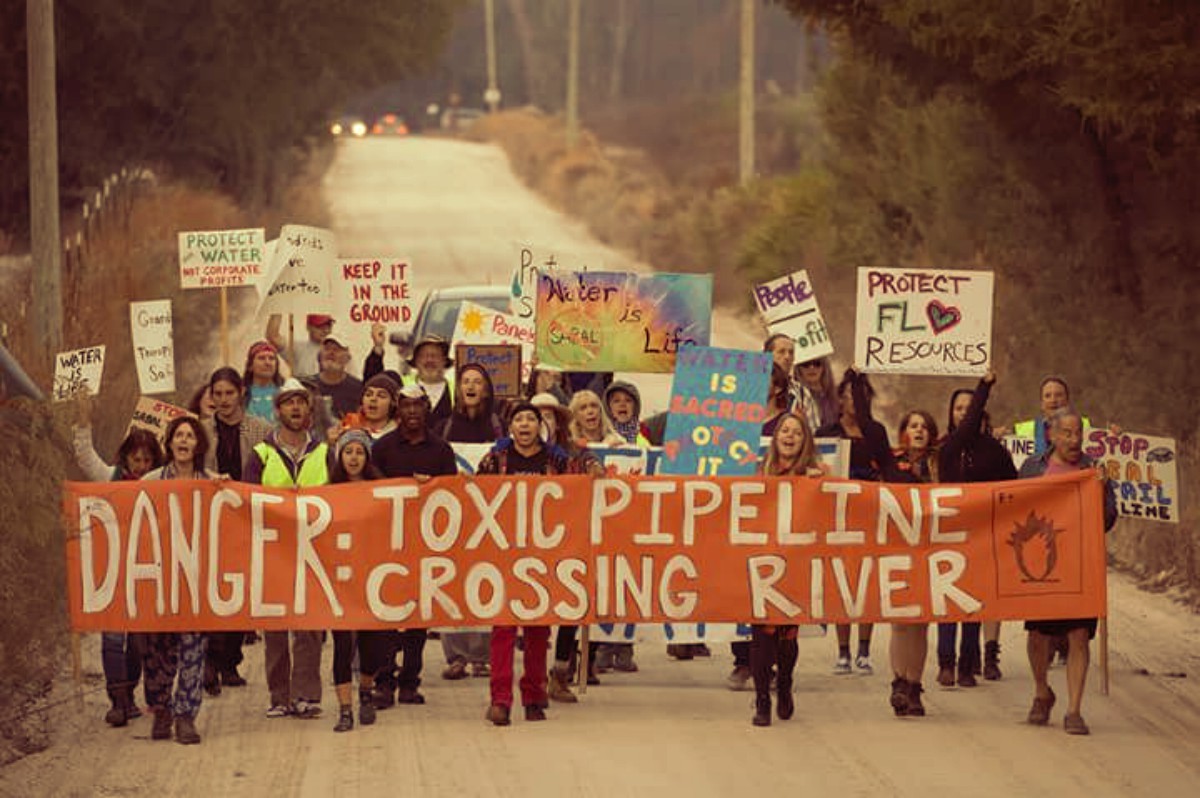Filed under: Action, Development, Environment, Land, Southeast

News about the Sabal Trail lawsuit, court updates, prisoner support and the emerging phosphate mine fight.
Some important events have happened since our last update. In August, a federal court found the Sabal Trail Pipeline’s Environmental Impact Statement (EIS) insufficient.The judges’ Order specifically forced the pipeline builders to release a Supplemental EIS which reassesses the impacts of greenhouse gas emissions not just during pipeline construction, but in it’s end use for generating energy. While this seems like a no-brainer, it was also a decision that rocked the oil and gas industry, which has relied on obscuring the big picture analysis of its devastating impacts.
One month earlier, water protectors who were on the ground opposing the Sabal Trail construction celebrated another victory as additional criminal charges against them were dropped in Gilchrist County, where protests and blockades slowed the drilling operation under the Santa Fe River in November and December 2016.
These legal victories for our movement dragged the pipeline pushers back into the national media spotlight.
They were both huge steps in the movement against the Southeast Market Pipelines that Sabal Trail is part of, but the journey must continue as this fight is still very much in play. In particular, we can now comment on the Supplemental EIS until November 20, 2017.
A member of the group SpectraBusters filed this into the record, to give you an idea of some points you may want to hit on in your comment. (Find out how to send your comment here).
FERC has done it again! It is amazing how FERC can review all these projects and come up with the same conclusions time after time – “ operating the SMP Project would not result in a significant impact on the environment.”
The SEIS states that the SMP Project would increase Greenhouse Gas emissions in the state of Florida by 3.7- 9.7 percent. The 9.7 percent increase is if all the fuel the pipeline could carry were to be burned, which FERC states is unlikely. In my opinion the “full burn” figures are the only figures to consider. If FERC wants to consider smaller figures they should have authorized a smaller pipeline! A 9.7% increase in GHG emissions (or 22.1 million metric tons) is very significant.
In the original evaluation of the SMP project FERC compared natural gas to coal and oil, leaving out all renewable sources of energy production including solar. FERC needs to consider Solar Power in this SEIS. When and if solar power is compared to natural gas and other fossil fuels FERC will discover that solar power has a 0% increase in GHG emissions.
The SEIS states: “We could not find a suitable method to attribute discrete environmental effects to GHG emissions.” FERC follows this statement with excuses as to why they cannot determine local environmental effects and impacts. We need answers not excuses! I am certain that the court order that required FERC to do this SEIS didn’t say- well if it is too difficult don’t worry about it. Maybe FERC should consider developing a method for determining local impacts of GHG emissions.
Under “Social Cost of Carbon” its more of the same rhetoric and excuses, FERC can’t find a tool to appropriately measure the social cost of carbon. Here again FERC needs to develop the tools necessary to do the job.
FERC needs to go back and redo this SEIS. Surely this report is not the best FERC can do. We the citizens of Florida expect and deserve a professional report that considers all options without a bunch of excuses as to why they can’t do the job. If FERC can not fully evaluate GHG emissions as they state in this report how is it they can say there will be no significant impacts.
In addition to sending a comment in the new EIS for these pipelines, you also have a chance to have your voice heard regarding Liquefied Natural Gas (LNG) exports, as the Department of Energy is reviewing the rules for regulating this industry growing alongside the pipelines. Find details on how to file your comment here.
Ongoing legal support
Water protectors Karrie Kay Ford and Niko Segal-Wright, initially facing felonies for crawling into a section of pipe under construction, had those charges dropped down to misdemeanors and resolved their cases without jail time, but they are still facing court-related costs and could use your help in covering those. (Donate to them directly using this link).
In addition to that case, we also have a water protector from the early days of the Sabal Trail resistance efforts who is now serving a four month prison sentence as a result of his arrest at the Trump Inauguration protests on January 20. Please send him a post card or letter at the following address. Check out a recent letter from him published on the website It’s Going Down.
Dane Powell #82015007
Federal Correctional Institution – Low PO Box 1031
Colman, Florida 33521
No ‘Phate But What We Make
There is a new struggle emerging in Springs Country. A phosphate mining proposal along the New River, a tributary of the Santa Fe, straddling Union and Bradford Counties, threatens to destroy 10,000 acres of forest, ranch and wetlands.
Keep an eye out on opportunities to speak out and organize against this plan by following the Citizens Against Phosphate Mining.
The Springs Region of North/Central Florida is home of the largest constellation of freshwater springs on the planet, with around 1000 springs being identified at last count.
Despite the deep and widespread love of this unique, amazing water-world under the ground that sustains the life of rare ecosystems, endangered species and millions of people, it is still under attack. And we are still intent on defending it.





